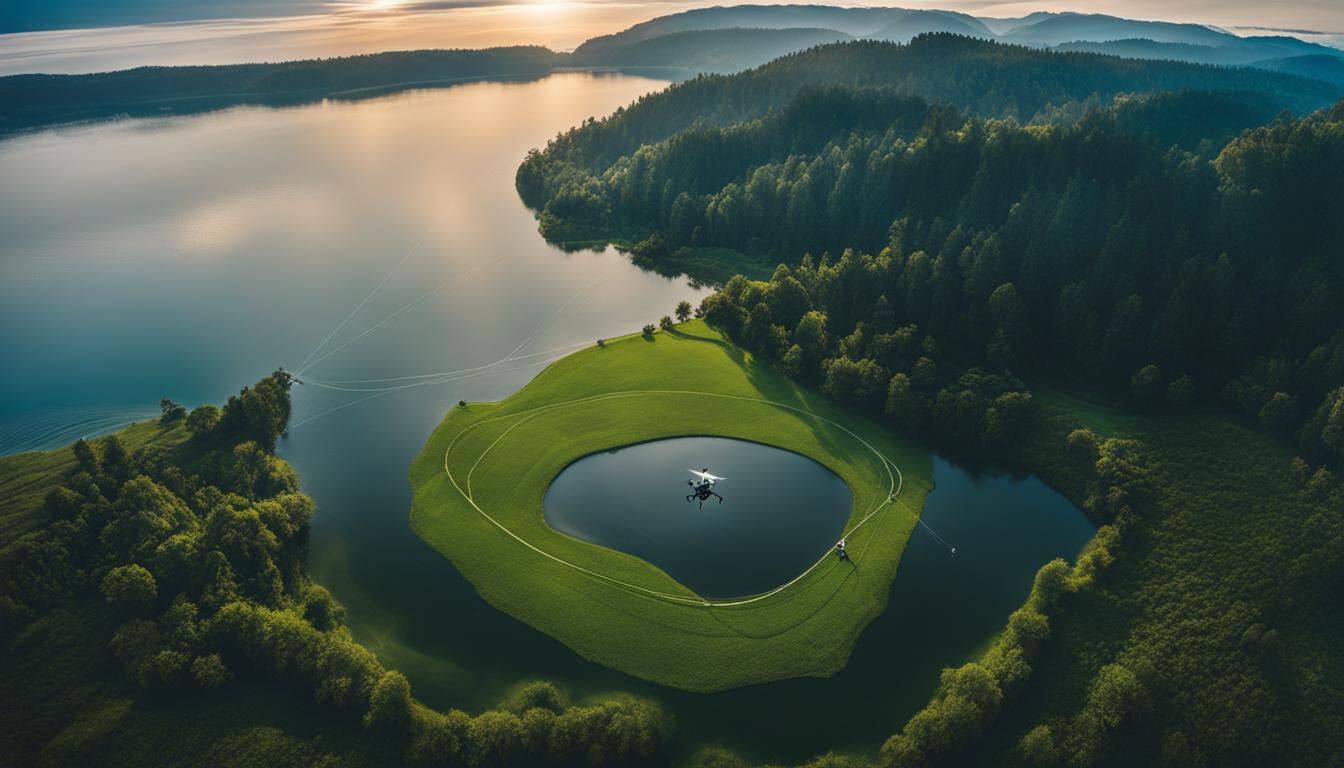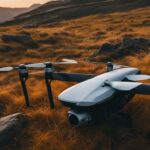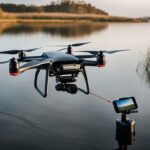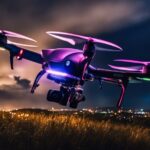As an ardent angler, I’ve always been fascinated by the ways technology can enhance my fishing escapades. That’s why I’m thrilled to talk about a game-changer in the fishing realm—drone fishing. This ingenious combination of the age-old sport and cutting-edge tech uses a remotely operated vehicle (ROV) to cast lines into those coveted hidden spots undisturbed by human presence. Simply put, it’s fishing elevated, giving you that edge for a potentially more significant catch. Let’s dive into this step-by-step guide that will arm you with the know-how to leverage a drone for your next big fishing adventure.
Imagine the allure of exploring uncharted waters, the promise of those unattainable casts now within your grasp, all thanks to your trusty drone. Whether you’re aiming for the deep blue sea or a remote stretch of river, the ability to tap into previously unreachable locations is at your fingertips—or should I say, at your controller’s joysticks. So, strap in as we set off on a journey that’s bound to redefine your relationship with fishing.
Key Takeaways: How to Drone Fish
- Drone fishing merges traditional fishing with advanced drone technology.
- Using a drone can markedly increase your chances of catching fish.
- Understanding the legal and safety aspects is crucial before starting.
- Thorough knowledge of equipment setup enhances the fishing experience.
- Success depends on mastering drone controls and fishing techniques.
- Practical strategies can overcome common challenges in drone fishing.
Welcome to the Future of Fishing: An Introduction to Drone Fishing
My foray into the world of angling took a revolutionary turn the moment I embraced drone fishing. By harnessing the power of UAV technology, I found myself ushered into a domain where the best fishing spots, previously veiled by distance and inaccessible terrain, were readily within my reach. Drone fishing extends the boundaries of traditional angling methods, presenting me with an entirely new array of possibilities and challenges.
Imagine the capability to fly a drone out where the waves break beyond the casting capabilities of even the mightiest fishing rods. There, the drone delicately places the bait, inviting the coveted big catch into my arena. The dynamic nature of this fishing approach empowers enthusiasts like me to not only reach farther but to see more—the ripples of fish activity, the undulations of the ocean floor, all from a vantage point that’s been a mere dream until these recent technological strides.
- The precision of a well-placed bait with a drone.
- Scouting for fish from an aerial viewpoint.
- Realizing the breadth and depth of your fishing landscape.
As I ventured into drone fishing, I became acutely aware of its multifaceted impact. It’s not just the extension of casting range—it’s the expansion of my understanding of the water I fish. It’s the answer to the question, “What lies beyond that rocky shore, where my line has never reached before?”
Drone fishing is an intersection of patience and innovation, where the sky isn’t the limit, but where the line meets the water.
While seasoned experts may find the integration of technology into their angling routine a refreshing change, novices also stand to gain a formidable edge. Drone fishing is a leveling platform, a shared space where every fisher can transcend the limitations of their cast and indulge in the pure thrill of exploring unbridled waters.
Whether it’s a placid lake, the turbulent sea, or the many nuances of a flowing river, my drone becomes the keystone to unlocking spots rife with potential, teeming with the promise of a bountiful catch. There’s something truly magical about watching a drone hover over the glistening expanse, suspending bait with precision, and seeing the water stirred by the promise of what lies beneath.
In this transition to advanced angling, I am no longer confined by the shore. I am liberated, free to roam the big water blues and freshwaters alike, without ever casting off from solid ground. This is what it means to be at the frontier of modern fishing—it’s thrilling, it’s expansive, and it’s mine to explore.
Understanding the Legal and Safety Aspects of Drone Fishing
Embarking on a drone fishing adventure brings with it a blend of excitement and responsibility. As much as I am eager to sail my drone across the waters, hoisting my line to the air and waiting for that thrilling tug of a catch, I’m conscientiously aware that the activity is governed by rules almost as intricate as the sport itself. Without proper adherence to these regulations, one’s day of conquest could quickly descend into a quagmire of legal headaches.
Compliance with Drone Fishing Regulations
To keep the thrill of drone fishing pure and unblemished by legal consequences, I ensure that I’m versed in the mosaic of regulations set by the authorities in my fishing locale. This involves a thorough check of drone registrations, a confirmation that I’m steering clear of no-fly zones, and a meticulous adherence to altitude directives. It’s the groundwork mandatory for all drone anglers, the prerequisite homework before the play.
- **Registration**: Make sure my drone is registered with the Federal Aviation Administration (FAA).
- **Altitude Restrictions**: Respecting altitude limits to avoid interference with manned aircraft.
- **No-Fly Zones**: Staying updated on areas restricted from drone operation.
Importance of Safety Precautions and Gear Inspections
Safety isn’t just a protocol; it’s my beacon on the water, ensuring that my sporting ambition doesn’t become a peril for others or myself. Hence, before launching my drone, pre-flight gear inspections are just as habitual to me as tying a hook to a line. Scrutinizing battery health, cross-checking propeller integrity, and confirming the drone’s overall condition are steps that can’t be skipped—drone readiness is as vital as my own readiness.
- **Battery Inspection**: Checking for full charge and sound health.
- **Propeller Check**: Ensuring propellers are damage-free and secured.
- **Drone Examination**: Verifying the general condition and firmware updates of the drone.
Ensuring safety in drone fishing is not just about following rules; it’s about fostering a culture of responsibility every time the drone takes to the skies.
Apart from these inspections, I am always conscious of keeping my aerial angler buddy at a safe distance from people, wildlife, and other crafts. It’s this commitment to safety that blossoms into responsible enjoyment, clearing the path for an eventful day chasing the whispers of the water.
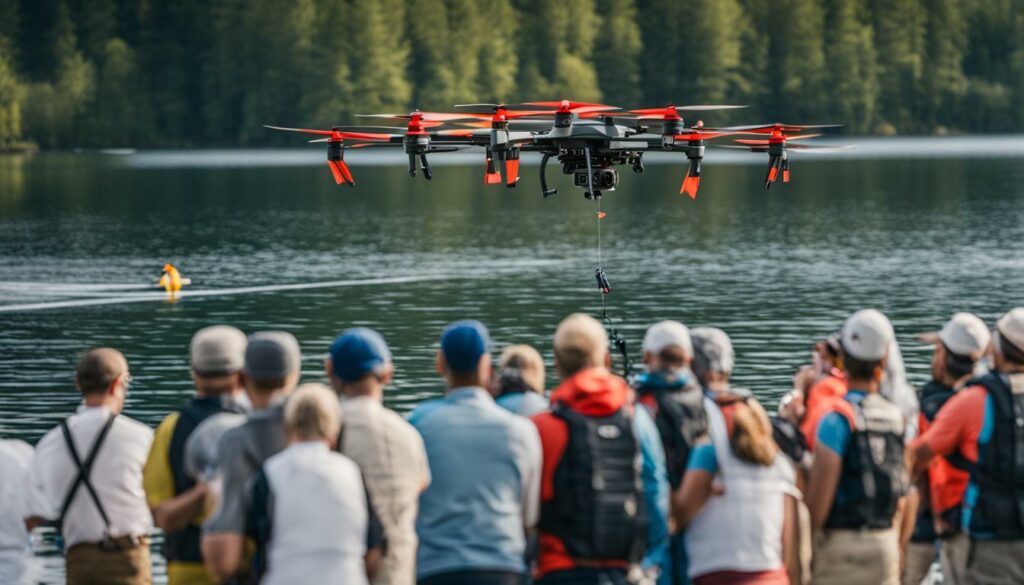
These are the unspoken pacts I uphold with my drone fishing endeavors—the fine lines between thrill and threat, and the cognizance that my pursuit of a hobby must never eclipse the overarching ethic of care for my surroundings.
- Maintain vigilance for weather advisories.
- Always keep the drone within the line of sight.
- Strategic area scouting to ensure a clear and secure flight zone.
All these measures, checks, and balances form my pre-flight ritual, aligning my excitement for the catch with the sobering mandates of the law and the non-negotiable demands of safety. It’s the tie that binds, leading to countless adventures amid the skies and waters, each hemmed with caution and mindful of the greater goodwill.
Choosing the Right Drone for Your Fishing Adventure
When I first dipped my toes into the waters of drone fishing, I quickly realized the importance of selecting the ideal fishing drone. It’s not just about the thrill of sending a gadget skyward; it’s about choosing the right partner for a seamless angling dance. With several factors in play, picking a drone that suits your needs can be as critical as the bait you choose.
Factors to Consider When Selecting a Fishing Drone
As an ardent fan of drone fishing, I’ve learned to weigh certain factors heavily when shopping for a fishing drone:
- Flight Time: A drone with a prolonged flight time ensures I can cover more area and have ample time to scout for the best fishing spots.
- Payload Capacity: More payload capacity means I can carry the necessary gear without compromising the flight performance of my drone.
- Stability: A stable drone, bolstered by features like GPS stabilization, is less susceptible to the whims of the wind and more precise in bait deployment.
- Control Range: The further the range, the farther off the beaten track I can venture in search of the perfect catch.
Moreover, the construction of the drone should scream durability, withstanding the moist and sometimes salty conditions encountered during fishing outings.
Comparing Aerial and Underwater Drones for Fishing
In my quest for underwater trophies, I’ve contemplated both aerial and underwater drones—each offering distinct benefits depending on my objectives. Here’s a breakdown:
| Aerial Drones | Underwater Drones (ROVs) |
|---|---|
| Broad overview of the fishing area from above | Close-up views of the underwater environment |
| Capability to carry and release bait remotely | Navigation through currents and around underwater structures |
| Equipped with cameras for real-time scouting | live streaming of marine life action |
An aerial drone is my go-to for those serene days when I want to scout from above, gracefully dropping bait in promising locations. Conversely, an underwater drone is perfect for those curious about what lurks below the surface—offering a submarine vantage point that is nothing short of spectacular.
I cherish the versatility drones offer, each kind possessing unique capabilities that complement my fishing style—be it sky-high or deep-diving explorations.
Setting Up Your Drone for the Ultimate Fishing Experience
As I gear up for another round of drone-assisted angling, I recognize that a successful day on the water hinges on meticulous preparation. To transform my drone fishing from a mere trial to a trove of catches, I attend to each preparatory detail with the utmost care and attention. Properly setting up my drone is crucial, as it lays the foundation for seamless operation during my fishing excursion.
Preparation is the harbinger of success in drone fishing. A fully charged battery and rigorously tested gear ensure that my focus remains on the catch, not on technical interruptions.
Here’s how I prepare my drone to enhance my fishing adventure:
- Enhance Power Longevity: I ensure all batteries are fully charged for maximum flight time. Just as a well-stocked tackle box is key for fishing, so is a powered-up drone for drone fishing.
- Firmware Updates: Checking for the latest firmware updates has become a part of my routine, keeping my drone’s performance at its peak and taking advantage of the latest features and improvements.
- Attach Necessary Accessories: My drone is customized with the essential accessories, notably the bait release mechanism – a pivotal tool that bridges my drone to the waters below.
- Test Before Takeoff: I never hit the waters without giving my gear a dry run. Testing each component, especially the bait release, ensures they function as intended when it’s game time.
Furthermore, I consider the possibility of water mishaps seriously. Adding a float system to my setup provides a safety net, preserving my fishing line and drone in the event of an unforeseen plunge.
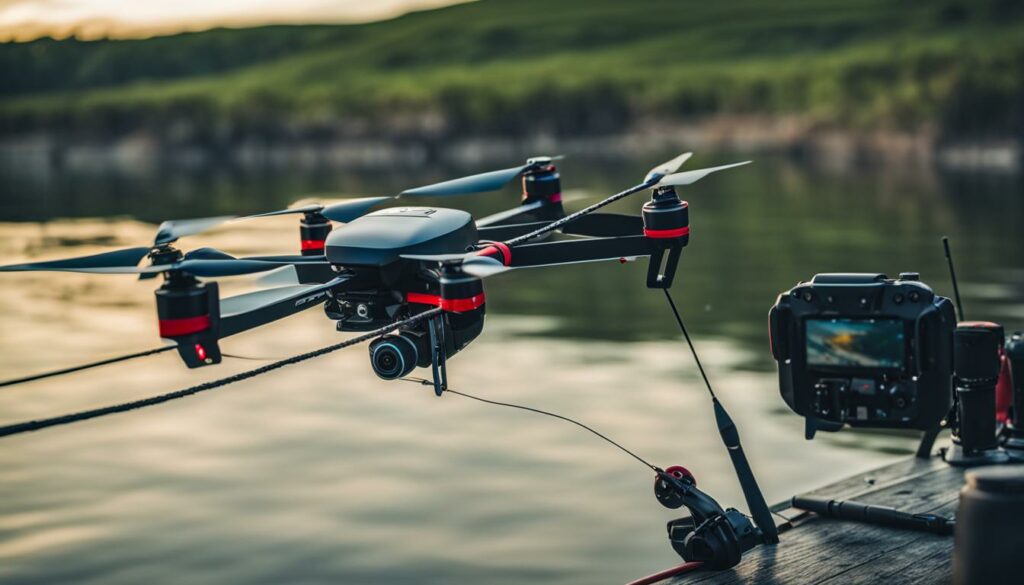
To encapsulate the essentials of drone preparation, I’ve created a table that summarizes the key points:
| Preparation Phase | Action Items |
|---|---|
| Power Up | Charge drone and controller batteries; ensure bait release mechanisms are powered. |
| Software Check | Update to the latest drone firmware for optimal performance. |
| Accessory Attachment | Fix necessary fishing gear such as bait release systems, and ensure they are operational. |
| Component Testing | Perform a trial of all features onshore to prevent disruptions at sea. |
| Safety Measures | Implement a flotation device to prevent sinking in case of contact with water. |
This table acts as a checklist that I rely on each time I set out to harness the innovative techniques of drone fishing. It’s a ritual that has proven critical for experiences that blend technology with the ancient allure of fishing.
In every element of preparation, I am as thorough as a captain charting a course for uncharted waters. It is this dedication to readiness that has empowered me to elevate my fishing experiences to new, unprecedented heights.
Attaching and Rigging Your Fishing Gear to the Drone
When I’m setting up my drone for fishing, I’m as delicate and precise as a surgeon. Attaching and rigging your gear requires extra attention to detail to make sure everything is secured properly. There’s an art to ensuring that the fishing line, bait, and all the components work cohesively with your drone. Let me walk you through the process so you can get your setup just right.
Step-by-Step Guide to Securing Fishing Line and Bait
- **Start With the Fishing Line:** Tie your selected fishing line firmly to the drone’s release mechanism. I always double-check the knot for security because a lost line is like a fisherman’s tale—full of disappointment.
- **Integrate a Swivel:** Fasten a swivel to prevent line twists and tangles—it’s like an insurance policy against the unpredictable whims of wind and current.
- **Regulate Depth With a Sinker or Bobber:** Depending on your target depth, attach a sinker or bobber to the swivel. This step determines your bait’s strike zone—it’s a balancing act between the surface play and the deep dive.
- **Secure the Bait:** Finally, tie your bait or lure to the line. Whether it’s a tempting jig or a live minnow, I make sure it’s attached in a way that mimics natural movement—deception is key in this watery theatre.
Every knot, every swivel, and every lure plays its part in this aquatic symphony—tuning it to perfection could be the difference between a trophy catch and a fisherman’s forlorn fable.
It’s crucial that each step is meticulously carried out for the integrity of your fishing setup. Don’t rush through the process. Rushed knots lead to lost catches—an angler’s axiom. Examine every connection, ensuring that the fishing line’s strength matches your desired catch. After all, you wouldn’t go elephant hunting with a slingshot, would you?
Here is a breakdown of the rigging components I deem essential for affixing to the drone:
| Component | Function | Attachment to Drone |
|---|---|---|
| Release Mechanism | Ensures controlled bait drop | Securely mounted on drone |
| Swivel | Prevents twisting and tangling | Tied to the fishing line |
| Sinker/Bobber | Controls bait depth | Attached to the swivel |
| Fishing Rig | Holds bait/lure | Tied to the end of the fishing line |
Before you set your drone off into that horizon where the sky kisses the water, ensure that every piece of your fishing gear is harmoniously rigged to your mechanical fish spotter. It’s this groundwork that sets the stage for a successful outing.

From Takeoff to Cast: Navigating Your Drone to Prime Fishing Spots
Embarking on a drone fishing journey, I’ve learned that steering my drone to the prime fishing locales is akin to orchestrating an aerial ballet. The grace with which I can maneuver the drone, harnessing its controls and flight modes, has a palpable effect on my success. Mastering the subtle art of navigation is what separates a fruitful day from mere reconnaissance. That’s why I ensure that before my drone takes to the skies, I’m attuned to its nuances, and my fingers are well-versed in the dance of the joysticks.
Reading the waters from above, my drone’s camera is the lens through which I assess the promising whisperings of the deep. This bird’s-eye scouting is enhanced by the First Person View (FPV) capability, allowing me to vicariously soar and survey, all while remaining firmly planted on the shore. It’s a powerful advantage that turns guesswork into informed strategy.
Once I’ve spotted a potential jackpot of a location, it’s all about positioning. Gently, with precision, I navigate my airborne ally, elevating it to an optimal height – high enough to evade the splash zone, yet close enough for precision bait release. Here, the watchful camera below is my guide, ensuring my drone’s offerings are cast right where the fish teem.
- Pre-Flight Check: A commitment to thorough checks and essential adjustments ensures that my drone remains a well-oiled machine, responsive and ready.
- Knowing the Controls: It’s crucial to internalize every button, switch, and lever on my drone’s controller, turning reflex into intuition.
- Optimal Altitude: I determine the precise height for hovering, so the drop is neither too harsh to scare away the catch nor too soft to miss the target.
Gazing into the monitor, waiting for that plumb bait to bewitch a fish, I’m reminded that patience, too, is a tool at my disposal. The real contest begins now—scanning, waiting, and anticipating the grand tug below that aerial usher of mine.
The serenity of flight and the anticipation of a bite fuse into a singular experience where the world fades and the water below commands my attention.
| Navigation Task | Details | Significance |
|---|---|---|
| Preflight Preparation | Ensuring the drone and all its functionalities are in optimal condition. | Sets the tone for a seamless fishing experience. |
| Understanding Controls | Mastering the remote controller and various flight patterns. | Allows for deft drone manipulation and precise bait placement. |
| Flight Altitude | Flying the drone at the appropriate height for scouting and bait release. | Maximizes the efficiency of bait drops while avoiding any accidents. |
| FPV Utilization | Using First Person View to observe and locate fishing hotspots. | Provides a dynamic visual reference for finding the most active fishing areas. |
| Bait Release Strategy | Calculate the right moment to drop the bait into the water. | Increases the likelihood of attracting fish to the lure. |
As I maintain a close watch, my drone a silent sentinel in the sky, I am meticulous to avoid any contact that could compromise my flying fish-finder. Whether it’s a gentle push against the wind or a smooth glide over placid water, each movement is deliberate, a testament to the harmony between technology and tradition. For it is here, amidst the synergy of man, machine, and nature, that my angling aspirations take flight.
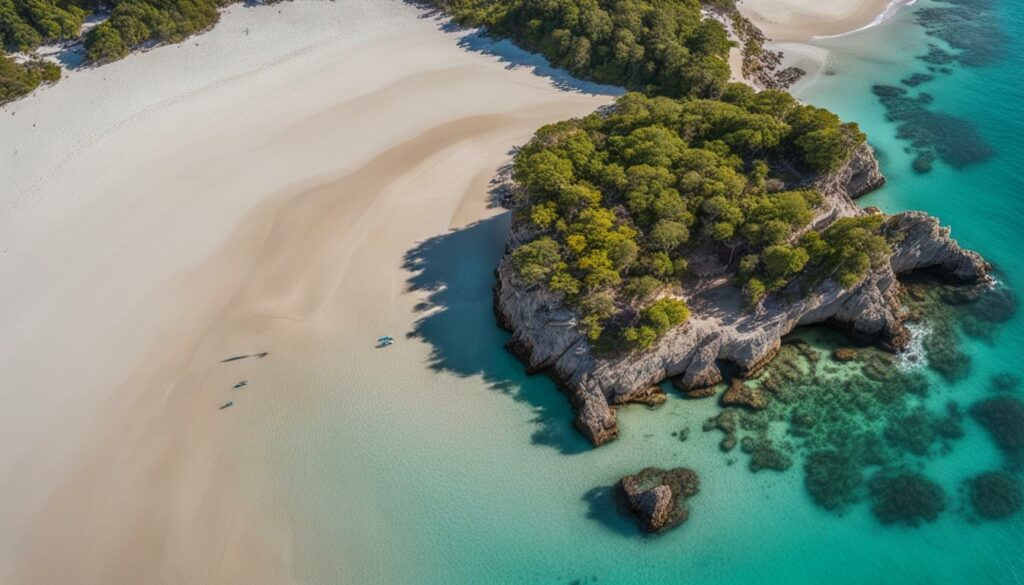
- I soar not just to seek, but to find. And in finding, to cast with the confidence that every decision rests on the wisdom imparted by a view from above.
- In my quest, it is not the distance covered but the attention to the depths below that carves my path to fishing mastery.
- Moments come alive within my grasp as I pilot my drone across the fluid mosaic below, in search of bounty waiting just beneath the ripples.
The transition from takeoff to cast, the voyage across the sky to the waters’ embrace, is but a dance – a choreography of meticulous preparation meeting perfect execution. As I guide my drone with measured breaths, each movement guided by experience and intuition, the lake becomes my canvas, the drone my brush, and each cast my stroke of possibility.
Making the Catch: How to Handle Bites and Reel in with a Drone
The zenith of drone fishing is the adrenaline-pumping moment when you realize you’ve got a bite. There’s a distinctive exhilarating rush that surges through me—it’s the culmination of preparation, patience, and technique. But with this climax comes the critical challenge: maneuvering both the drone and the catch with such finesse that neither the equipment nor the fish comes to harm.
The Art of Maintaining Tension and Maneuvering the Drone
I pride myself on the practice I’ve put into piloting my drone, which pays dividends when I feel that anticipated nudge on my line. Maintaining tension is a delicate balance—an art that has become second nature to me. Here, the careful interplay of gentle drone motions and vigilant line supervision is what keeps my odds of a successful reel-in high.
Upon detecting that telltale bite, I engage in smooth, planned movement to keep the fishing line taut. Quick elevation changes or sharp turns could jeopardize the gentle equilibrium between drone and fish—a risk I’m unwilling to take. My eyes, glued to the monitor, dictate my reflexes as I coax my prize closer.
- Monitor the Line: Consistent observation of the line’s tension is essential. It tells me more about the situation than any on-screen indicator ever could.
- Smooth Movement: Using the drone’s pitch, roll, and yaw, I respond to each tug with measured action, ensuring the fish feels a steady, yet gentle resistance.
- Controlled Operation: I handle the controls with care, keeping my movements balanced to navigate the drone as it mirrors the fish’s movements.
When the fish finally nears the surface, it’s a transitional moment that requires yet another tactical shift. It’s at this juncture I ready my landing net or gaff. With steadiness and precision, I guide the fish towards these tools, allowing me to safely and humanely bring aboard my aquatic adversary.
Ensuring the welfare of the fish post-capture is a responsibility I never overlook. Whether it’s destined for a return to the wild or for the dinner table, its treatment during and after the catch is paramount.
Respect for the fish, respect for the sport, and respect for my drone—this triad of respect defines my philosophy on the water.
In summary, see the table below for the tactics I implement when transitioning from detecting a bite to securing my catch:
| Stage | Tactics | Purpose |
|---|---|---|
| Detection of Bite | Employ smooth, gentle movements | To maintain line tension without alarming the fish |
| Reeling In | Maintain a steady drone altitude and use controlled maneuvers | To mirror the fish’s movements and ease it towards the surface |
| Securing the Catch | Prepare landing net/gaff for safe retrieval of the fish | To ensure the fish’s welfare and successfully conclude the catch |
Through a symphony of control and anticipation, where every subtle twitch counts, the chase concludes. I breathe a sigh of fulfillment as I secure my catch, all through the interconnectivity of drone and traditional angling—connected yet apart, a dance of the modern and the timeless.
Advanced Drone Fishing Techniques to Up Your Game
Drone fishing has ushered me into a realm where the confluence of technology and tradition transforms every excursion into an adventure. Pushing my fishing to new heights involves not just mastering the basics but also incorporating advanced techniques. In this turf of aerial angling, versatility is king, and finesse is the crowning glory. It’s a dynamic ballet of rigs, baits, and technological prowess, all harmoniously orchestrated to tip the scales in favor of an abundant haul.
Exploring Different Fishing Rigs and Bait Options
To keep ahead of the curve, I’ve ventured into exploring various rigs and baits, adapting my approach to the diverse behaviors of fish species. Every rig has its story, every bait its allure. The secrets of the underwater world unravel as I experiment, noting the responses, adjusting my methods, and refining my choices. Here’s a look at the tactical shifts and combinations that have enriched my drone fishing voyages:
- **Bottom Rigs**: For those elusive bottom dwellers, sinking the line to the depths where the benthic rituals unfold.
- **Floating Baits**: Engaging with surface feeders, my drone playing cupid, bringing bait and predator face to face.
- **Lure Selection**: A cavalcade of lures at my disposal, each chosen for its specific dance in the aquatic ballet, enticing the intended audience.
I’ve learned that understanding the subtleties of the natural domiciles of my quarry—be it the gentle slope of a sandbar that tempts the flatfish or the jagged embrace of a reef that harbors the colorful reef fish—is instrumental in deciding which rig and bait combination to deploy.
Utilizing Drone Cameras and GPS for Fish Spotting
The drone’s camera and GPS have become my powerful allies, eyes in the sky marrying technology with the primal skill of fishing. The camera, my vantage point into the depths, sheds light not only on the topography of my fishing theatre but also on the interplay of predator and prey. Through its lens, I observe the orchestrated movements of fish shoals and the shifting shadows on reefs—each a telltale signature of potential hotspots.
Utilizing GPS, I map these insights into a strategic framework. I chart paths over the water, plotting each cast with precision, ensuring my baits land amidst the frenzy of feeding schools or in the calm of a lurking giant. As I peruse the monitor, the GPS points cradle my strategy, laying a path that I meticulously follow, trace, and often, rejoice over.
The delight in witnessing a swarm of activity through the drone’s lens, the telltale signs of fish converging – it’s an edge that fuels my fishing quests with both thrill and effectiveness.
| Rig/Bait Type | Target Species | Fishing Environment |
|---|---|---|
| Bottom Rigs | Demersal Species | Sandbars, Reefs |
| Floating Baits | Pelagic Predators | Open Water, Near the Surface |
| Artificial Lures | Varied, based on lure type | Structured, Current-Rich Zones |
This wealth of information, and the myriad of techniques at my fingertips, cast each fishing excursion in a new light. It’s a journey of continual learning and adaptation, where my drone—the herald of a modern fishing renaissance—guides me through waters rich with promise and ripe with opportunity.
As you join me in embracing these advanced drone fishing techniques, let us cast our lines and our sights into the future—a future where persistence and innovation intertwine, yielding not only majestic catches but also endless tales worthy of the modern angler.
The Pros and Challenges of Drone Fishing
As a passionate fisherman, I’ve embraced drone fishing for its myriad of advantages, but I’m also acutely aware of the challenges that come with it. The spectrum of opportunities it introduces is vast, offering anglers like myself a new playbook in the angling game.
One of the most significant benefits I’ve experienced through drone fishing is the unparalleled access to expansive areas—covering miles of water without ever moving from my chosen perch. With the bird’s-eye view that my drone affords, I can scout for shoals of fish and drop bait in high-potential spots, all while observing from a safe distance. It’s this ability to quickly and efficiently canvas a large body of water that continues to transform my fishing outings.
Yet, for all its pros, drone fishing isn’t without its pitfalls. Problems such as line tangling—when the fishing line gets caught in the drone’s propellers—are a common headache. I’ve learned to counteract this challenge through careful line management and the use of specialized release mechanisms. Battery limitations are another concern, as the drone’s battery life determines how long I can spend on the water. Strategic planning and carrying extra batteries are essential solutions that have saved many of my fishing trips from ending prematurely.
Undoubtedly, embracing both the advantages and addressing the challenges has led to a more satisfying and productive fishing experience.
Fishing is an act of patience, but drone fishing asks for a blend of patience and precision—welcome to the future of the sport.
Let’s take a deeper look into what makes drone fishing so enticing, as well as some of the obstacles I have encountered and how I navigated through them:
- Pros: Increased coverage area, access to remote spots, aerial scouting capabilities.
- Challenges: Risk of line tangling, limited flight time due to battery life, and navigation in adverse weather conditions.
| Aspect of Drone Fishing | Advantages | Challenges |
|---|---|---|
| Coverage Area | Ability to explore vast water bodies efficiently | Physical limitations of battery life restricting coverage |
| Location Accessibility | Reaching previously inaccessible or remote fishing areas | Difficult navigation over rugged or complex landscapes |
| Fishing Line Management | Remote deployment of fishing lines and baits | Potential tangling of line with the drone’s propellers |
To mitigate these challenges and bolster the pros, I invest time in figuring out the best strategies for each location I target. Experience has taught me that what works in a placid lake may not apply in the churning sea. Keeping up to date with the latest drone models and technologies also gives me an edge, enabling me to utilize the most advanced features for a more seamless fishing experience.
Every time I deploy my drone over the waters, I’m reminded that adaptation and resilience are key. The blending of high-tech gadgetry with the traditional rod and reel is not just a fusion of past and present, but a path forward in the fishing narrative.
In essence, as we push the boundaries of what’s possible in angling, we also learn to face and overcome the challenges that come with innovation. After all, it’s the surmounting of such obstacles that makes the reward—the catch—so sweet.
Conclusion: The Transformative Journey of Drone Fishing
As I reflect upon the transformative journey that drone fishing represents, I am continually astounded by the remarkable synergy of technology and angling. Rigging my drone, launching it into the calm of the sky, and watching it effortlessly conduct my bait to its destination marks a revolution in the time-honored tradition of fishing. By adhering to the safety protocols, committing to selecting the right equipment, and refining my piloting skills, I have managed to elevate my fishing game to new heights—literally and figuratively.
The intricate dance of drone flight and the careful anticipation of a catch meld into a harmonious experience that reshapes what it means to fish. It’s not merely about the catch, but also about the majesty of embracing innovation while respecting the long-standing customs of fishing. Continued practice, a keen awareness of regulations, and a persistent curiosity have been my companions on this exciting adventure. They remind me that with every launch of my drone, there’s a world of possibility waiting to be discovered across the blue expanse. And with every successful catch, a fresh tale to tell that weaves the old with the new in this modern tapestry of fishing.
Drone fishing isn’t just about adopting new technology; it’s about venturing into a realm of endless potential and discovery. Each trip onto the water is an opportunity to merge patience with precision, to harness the power of a drone to reveal secrets held beneath the waves. It’s clear to me now—drone fishing isn’t just a fad, it’s the future. And I eagerly look forward to casting my line into that future, where every fisherman has the sky a limit and every catch is a step toward the next grand adventure.
FAQ
What is drone fishing and how does it work?
Drone fishing involves using a drone to extend your fishing capabilities. By employing a drone, you can carry your bait and fishing line out beyond the casting range of a traditional fishing rod, drop the bait in the water at a pre-determined spot, and wait for the fish to bite. The drone can be equipped with a camera and a bait release mechanism, allowing for precise placement and monitoring of the fishing bait.
What are the legal requirements for drone fishing?
The legal requirements for drone fishing vary depending on the location. You must adhere to FAA regulations, which may include registering your drone, observing altitude restrictions, and avoiding no-fly zones. Always check local laws and regulations to ensure you are compliant when drone fishing.
How important are safety precautions when drone fishing?
Safety is of utmost importance in drone fishing. It’s essential to conduct pre-flight checks, maintain safe distances from people and wildlife, and ensure your drone is in good working condition before and during the fishing experience to prevent accidents and disturbances.
What should I consider when choosing a drone for fishing?
When selecting a drone for fishing, consider factors like flight time, payload capacity, stability in varying weather conditions, control range, and features like GPS and camera quality. The drone should be capable of safely carrying and releasing your bait at the chosen fishing spot.
Do I need a specific type of drone for fishing?
You’ll need a drone that can carry the weight of your fishing line and bait and one that has a method for remote bait release. Ideally, look for drones that are designed with fishing in mind or are robust enough to handle the attachment of fishing gear without compromising stability and performance.
How do I set up my drone for fishing?
To set up your drone for fishing, make sure the drone battery is fully charged, the firmware is up to date, and you have attached the required fishing accessories, such as a bait release mechanism. It’s important to practice flying and releasing the bait before going out to fish.
Is it difficult to rig my fishing line to the drone?
Rigging your fishing line to the drone involves careful steps but isn’t necessarily difficult. You’ll need to secure the fishing line to the drone’s release mechanism, preferably using a swivel to avoid line twists and ensure all connections are strong and secure. Testing your setup on land before heading to water is a smart move.
How do I navigate the drone to find the best fishing spots?
Use your drone’s camera and GPS to explore large areas and identify promising fishing locations, such as fish schools, reefs, or undersea structures. Understand how to control the drone and make use of flight modes to position the drone and release the bait in the chosen spot efficiently.
Can the drone reel in the fish for me?
No, the drone is not used to reel in the fish. Once a fish bites, you use your hand-held rod and reel to land the fish, employing the drone only to keep the line tension steady and help guide the fish if necessary. The drone should not be subjected to the heavy strain of reeling in a catch.
Are there advanced techniques for drone fishing?
Yes, advanced drone fishing techniques involve experimenting with different bait types, and rigs, and understanding fish behavior and patterns. Using the drone’s camera and GPS can further refine your approach by allowing you to monitor fish movements and adapt your tactics in real time.
What advantages does drone fishing offer over traditional fishing methods?
Drone fishing allows you to access hard-to-reach spots, cover larger areas quickly, drop bait with precision, and gain a unique vantage point via the drone’s camera system. These advantages can significantly increase your chances of catching fish in areas that might otherwise be inaccessible.
What are some challenges I might face while drone fishing?
Challenges with drone fishing can include managing battery life, avoiding line tangling, ensuring the drone’s payload capability matches your gear, and dealing with various weather conditions. Strategic planning and knowing your equipment well can help mitigate these issues.
How do I ensure a humane catch while using a drone?
To ensure a humane catch, use the drone to guide the fish and maintain tension on the line. Be prepared with a landing net or a fishing gaff to safely retrieve your catch from the water, minimizing stress and injury to the fish.
Are there specific models of drones recommended for fishing?
While there is no one-size-fits-all recommendation, certain models are popular among drone fishers for their reliability and functionality. Drones with good payload capacity, stability, and long battery life, such as the DJI Phantom 4 or DJI Mavic series, are often recommended. However, it’s best to research fishing drone reviews to find one that suits your specific needs and budget.
Can I use my existing recreational drone for fishing?
It’s possible to use your recreational drone for fishing if it meets the necessary criteria for payload, and stability, and has the capability to attach a bait release mechanism. However, ensure that the drone can safely handle the additional demands of fishing applications to avoid risking damage to your equipment.


